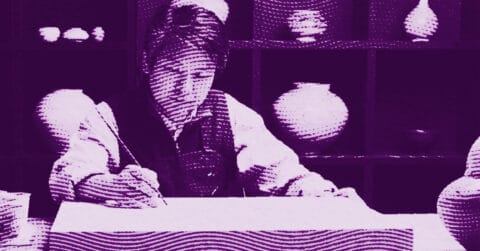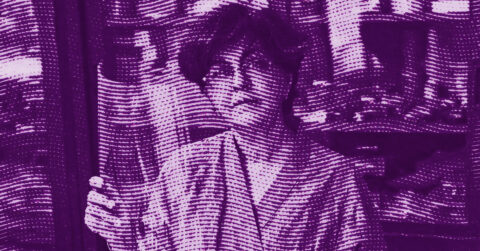Listen to me carefully, you bunch of snobs, if you think art is only about aesthetics and visual pleasure, think again! Tania Mouraud forces us to look beyond the visible, to scrutinize what lies behind the signs. This artist with a unique career has made language, perception, and engagement the pillars of a work as diverse as it is coherent, as sensitive as it is political.
Born in 1942 in Paris to a lawyer father and Resistance fighter killed in Vercors, and a mother who was also a journalist engaged in the Resistance, Tania Mouraud carries within her this tragic history that has shaped her relationship to the world. “My personality was built on the mourning of the family. My mother was a survivor. In my misfortune, I was lucky that my father died in Vercors and not in a camp. I am the daughter of a hero, not a victim,” she confides [1]. This experience of mourning and this acute awareness of history run throughout her work, like an invisible but persistent thread.
Self-taught, Tania Mouraud trained through contact with European avant-gardes. After exploring painting in the 1960s, she symbolically burned all her canvases in 1968, a public auto-da-fé marking her break with academicism to engage in forms of conceptual and minimalist art. “I was incapable of producing pictorial sensuality, incapable of producing the light that makes painting painting” [2], she explains.
But do not see in this radical gesture a mere nihilist stance. As Jacques Rancière explains in his book “The Distribution of the Sensible,” art does not just represent the world, it participates in its reconfiguration [3]. By destroying her paintings, Mouraud was not ending her creation; she was rather opening new spaces of expression and thought, in line with the idea that art must be inscribed in social life, address spectators directly, and confront them with their perceptions.
Thus, from 1968, she develops her first “Initiation Rooms,” these white and lacquered environments intended for introspection and sensory experience, “an extra space for an extra soul,” in the words of Pierre Restany [4]. Meditation spaces where the visitor is invited to experience their own consciousness, these minimalist rooms are part of a research on perception that Mouraud will continue to deepen. “The proposals I made at that time were places to sit and contemplate space, to become one with space: trying to lose the limitation of the body. […] Trying to live the cosmic experience and understand that the limit of the body is the cosmos” [5].
This research then takes on a more explicitly political and social dimension with Mouraud’s urban interventions, starting with the famous “City Performance No. 1” (1977-1978). The artist installed 54 billboards in Paris, each simply bearing the word “NI” in large black letters on a white background. “NI, operation without follow-up, no teasing, no disguised advertising from the Ministry of Culture. Simply an anonymous stance. Absolute negation, absolute truth, a universal circuit breaker used by Western logicians and Eastern sages” [6]. In a public space saturated with advertising signs, this enigmatic “NI” acts as a semiotic short circuit, an interruption in the continuous flow of consumerist incitements.
As Roland Barthes analyzed in “Mythologies,” our daily environment is colonized by signs that, under the guise of being natural, convey ideologies [7]. Mouraud’s “NI” precisely destabilizes this supposed obviousness of the signs around us. It creates a space for reflection where usually the consumerist injunction prevails.
Starting in the 1980s, Mouraud developed her famous “Wall Paintings,” these huge murals where phrases, stretched to the brink of legibility, form graphical motifs with an abstract appearance. “I HAVE A DREAM,” “WHAT YOU SEE IS WHAT YOU GET,” or “HOW CAN YOU SLEEP,” these messages reveal themselves only to the attentive viewer ready to take the time to decipher them. This demand for concentration is itself a form of resistance to the generalized acceleration of our societies, as Paul Virilio keenly analyzed in “Speed and Politics” [8]. Facing a culture of instantaneity and immediate gratification, Mouraud opposes a slow temporality, that of contemplation and deciphering.
The typographic dimension of her work also evokes the research of the concrete poet Augusto de Campos, for whom the visual arrangement of letters is just as important as their meaning [9]. For both Mouraud and de Campos, language is not only a vehicle of meaning but a full plastic material.
Alongside these investigations on language, Tania Mouraud explores other mediums, notably photography and video. Her series “Made in Palace” (1980-1981), made in a Parisian nightclub, captures bodies in motion, blurry, almost abstract. “I am not familiar with modern psychotropics,” she specifies. “My generation, it was acid, mescaline, LSD. Parties can be very beautiful, but they’re always on the edge, very sad. I especially don’t want to romanticize the Palace, but the people there were very beautiful, they were in costume” [10]. These photographs on the border of abstraction visually translate what Deleuze called “a body without organs,” this dissolution of bodily boundaries in the trance experience [11].
From the 2000s onward, video took a major place in Mouraud’s work, notably with striking works such as “Sightseeing” (2002), which takes us to the Natzweiler-Struthof concentration camp in Alsace, or “Ad Infinitum” (2008), which films in black and white the hypnotic choreography of whales. “The viewer is in the place of the camera and is confronted with what emerges from the water, a shapeless and unknown mass” [12]. The formal beauty of these images often contrasts with the violence of the subjects addressed, creating an aesthetic and emotional tension that leaves the viewer changed.
In 2014, with “Ad Nauseam,” a monumental video installation presented at MAC VAL (Contemporary Art Museum of Val-de-Marne in France), Mouraud confronts us with images of a book recycling factory, where machines relentlessly shred thousands of volumes. Accompanied by a sound creation produced in collaboration with IRCAM (the French Institute for Research and Coordination in Acoustics/Music), this powerful work metaphorically evokes the destruction of culture by industry. Susan Sontag would undoubtedly have seen in this work a perfect illustration of what she called in “Against Interpretation” an “eroticism of art” [13], where the sensory and emotional dimension takes precedence over intellectualization.
Because this is indeed one of the strengths of Tania Mouraud’s work: she addresses both our intellect and our senses. Her sound work, which she develops through her performances as a DJ and her installations, bears witness to this special attention paid to the sensory dimension of the artistic experience. “I have extremely precise ideas. I am a follower of Michel Chion, writer, composer, teacher, very concerned with the relationships between image/sound/music/word, and of Pauline Oliveros, musician and composer who originated deep listening, a slow and spiritual way of apprehending music” [14].
Since 2017, Tania Mouraud has been interested in Yiddish and incorporates this language into her artistic work, notably in her series “Mots-Mêlés” (2017-2021), where poems or opera excerpts are hidden behind black fields. This approach is part of a desire to preserve and keep alive languages and cultures threatened with extinction. As anthropologist Claude Lévi-Strauss showed in “Tristes Tropiques,” the disappearance of a language is equivalent to the irretrievable loss of a unique worldview [15].
Through her artistic journey, as rich as it is varied, Tania Mouraud has continually questioned our relationship with the world, history, and perception. Her work, deeply rooted in an ethic of responsibility, invites us to remain vigilant in the face of the violence of our times. “I feel closer to the notion of citizenship, which for me is an attitude toward life. Being a citizen means living with eyes open to the world” [16], she declares.
While we will be able to see a collection of works by Tania Mouraud at the Claire Gastaud gallery booth at the Drawing Now 2025 fair in Paris (March 27 to 30, 2025) and at the Art Paris 2025 fair (April 3 to 6, 2025), it is good to remember that Tania Mouraud’s art does not just represent the world; it pushes us to look at it differently, to perceive what hides behind the obviousness of appearances. And perhaps that is her greatest lesson: art is not a refuge cut off from reality, but rather a means to confront it with clarity and courage.
As Cécile Renoult so rightly points out about the exhibition “Why Do the Hills Cry?”: “Tania Mouraud achieves the feat of constantly reinventing herself while inviting us into a coherent universe. Her recent works dialogue with older pieces, both formally and through the echo of a shared philosophy” [17]. This coherence within diversity, this ability to renew herself without ever renouncing herself, is what makes Tania Mouraud a major artist of our time, whose work resonates as an echo to our concerns and hopes.
- Interview with Marie-Laure Desjardins, “Tania Mouraud: The Work is a Confidence,” Arts Hebdo Médias, June 1, 2024.
- “Experimenting with the Song of the World. The Art of Tania Mouraud,” Julie Crenn, May 24, 2011.
- Rancière, Jacques, “The Distribution of the Sensible,” La Fabrique, 2000.
- Arnauld Pierre, “Towards Space” in “Tania Mouraud,” Flammarion, 2004, p.25.
- Catherine Grenier, “Interview with Tania Mouraud” in “At The Core: Tania Mouraud,” ESBEMA, 2010.
- Tania Mouraud, “City Performance No. 1” in “Tania Mouraud,” Le Quartier, 1996, p.66.
- Barthes, Roland, “Mythologies,” Seuil, 1957.
- Virilio, Paul, “The Speed of Liberation,” Galilée, 1995.
- Campos, Augusto de, “Poetamenos,” 1953.
- Hugo Vitrani, “Tania Mouraud, a Splinter in the Throat,” September 2022, Ceysson & Bénétière, text of the exhibition “Flashback” from October 20 to December 3, 2022.
- Deleuze, Gilles and Guattari, Félix, “A Thousand Plateaus,” Éditions de Minuit, 1980.
- Alice Fleury, “Interview with Tania Mouraud” in “Ad Infinitum, Tania Mouraud,” Fages, 2009, p.27.
- Sontag, Susan, “Against Interpretation,” Farrar, Straus and Giroux, 1966.
- Interview with Marie-Laure Desjardins, “Tania Mouraud: The Work is a Confidence,” Arts Hebdo Médias, June 1, 2024.
- Lévi-Strauss, Claude, “Tristes Tropiques,” Plon, 1955.
- Granja, Christelle. Interview with Tania Mouraud, “I Live with Open Eyes,” Libération, December 10, 2015.
- Renoult, Cécile. Text of the exhibition “Why Do the Hills Cry?” at the Claire Gastaud Gallery (Clermont-Ferrand), October 3 to November 23, 2024.
















